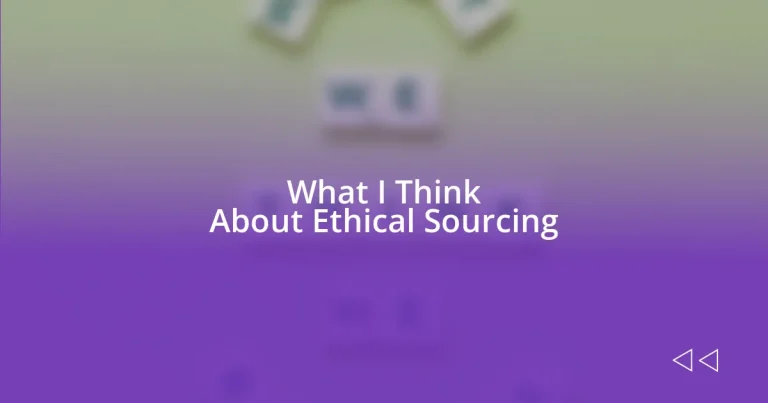Key takeaways:
- Transparency in sourcing fosters trust and empowers consumers to make informed decisions, driving positive change in the market.
- Evaluating supplier ethical practices involves assessing their code of conduct, third-party audits, and stakeholder engagement to ensure accountability and commitment to fair labor practices.
- Implementing ethical sourcing strategies, such as strong supplier partnerships and leveraging technology, enhances consumer engagement and promotes sustainable practices.
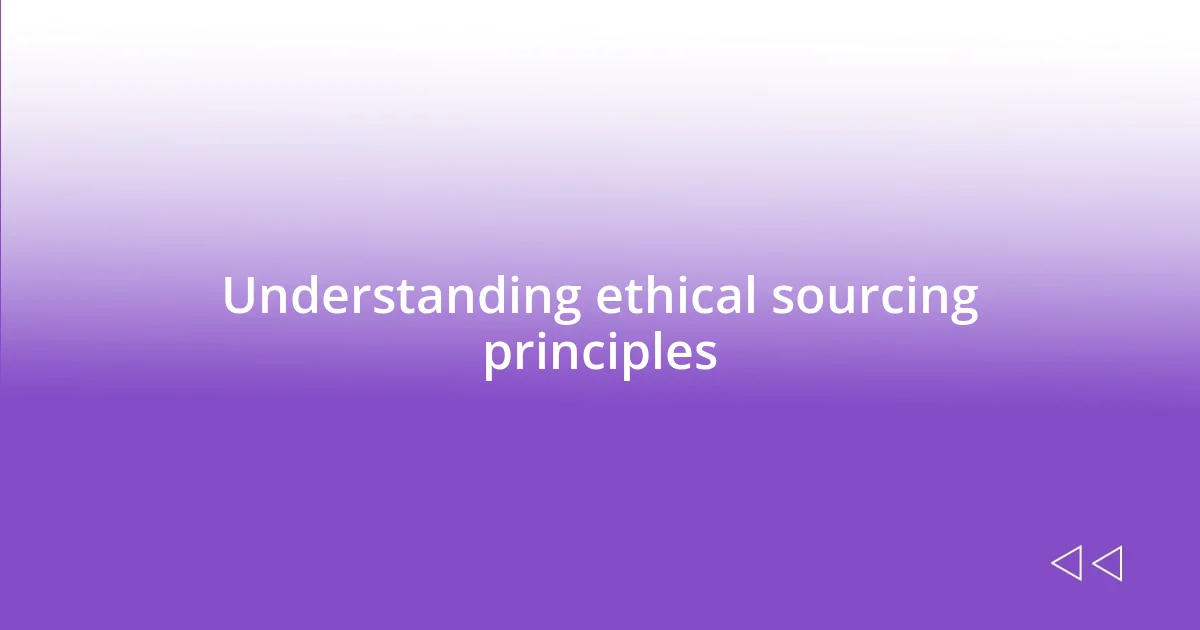
Understanding ethical sourcing principles
Ethical sourcing principles focus on ensuring that products are obtained in a responsible and sustainable manner. When I first learned about ethical sourcing, I was taken aback by the idea that every choice I make as a consumer has broader implications. It made me wonder: how often do we really consider where our products come from and the impact they have on the world?
One key principle is transparency, which means that brands should openly share information about their supply chains. I recall a time when I decided to examine the origins of my favorite coffee brand. I felt both empowered and anxious as I discovered how much traceability varied among brands. It reminded me that as consumers, we have a voice; our choices can influence how companies operate.
Additionally, fair labor practices are a crucial aspect of ethical sourcing. When I first encountered stories of workers facing exploitation, it struck a chord with my sense of justice. I often ask myself—wouldn’t I want the people behind the products I love to be treated with dignity? Understanding these principles isn’t just about knowing the facts; it’s about compassionate choices that align with our values.

Importance of transparency in sourcing
Transparency in sourcing is not just a buzzword; it’s a commitment that builds trust. I remember a conversation I had with a friend who works in supply chain management. He shared how companies that prioritize transparency often notice a boost in customer loyalty. It made me realize that when brands disclose their sourcing processes, they empower consumers to make informed decisions, fostering a deeper connection between them and their products.
Here are a few reasons why transparency matters:
- Trust Building: Customers are more likely to trust brands that provide clear insights into their sourcing practices.
- Informed Choices: Knowing where products come from enables consumers to support ethical brands that align with their values.
- Accountability: Transparency holds companies accountable for their actions, ensuring they live up to their ethical promises.
- Consumer Empowerment: When brands share their sourcing journeys, they give consumers the power to influence positive change.
I truly believe that a transparent approach can change the landscape of consumerism for the better. When I am aware of the stories behind my favorite brands, it transforms my shopping experience from a mundane task into a meaningful exchange.
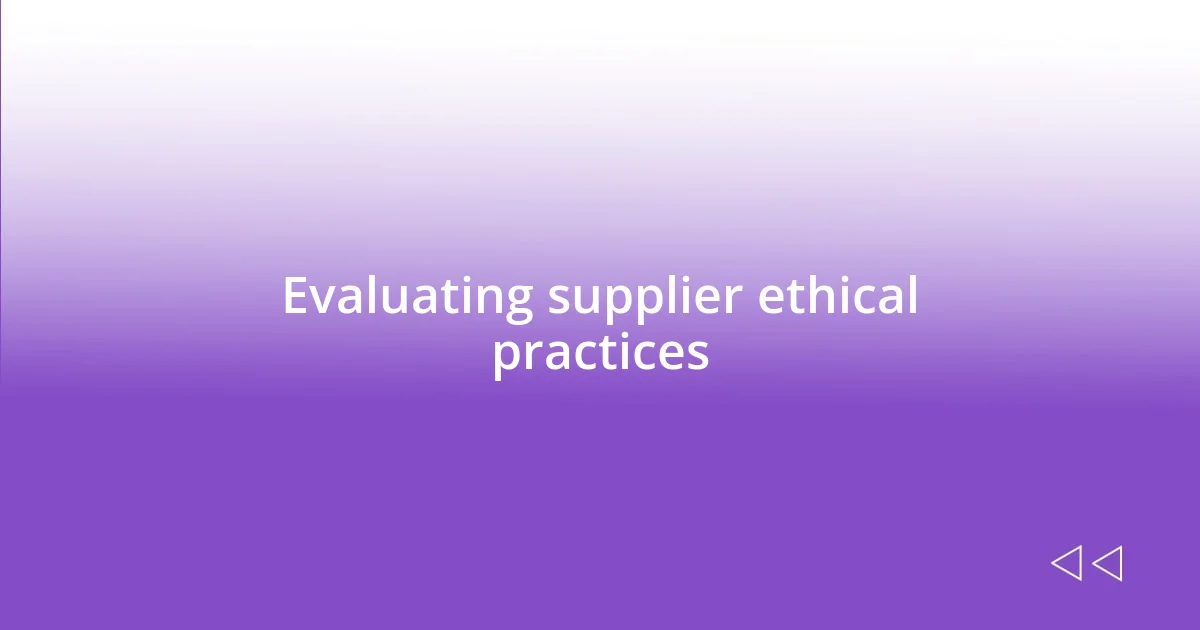
Evaluating supplier ethical practices
When I evaluate supplier ethical practices, I consider various dimensions, especially how they align with my values. One time, while researching a clothing brand, I stumbled upon their supplier code of conduct. I felt a surge of relief when I saw that they championed fair wages and safe working conditions. It made me think about the power of my purchasing decisions—choosing brands that care about their workers creates ripple effects for whole communities.
Another important factor is third-party audits. I remember coming across a report detailing how some companies employ independent auditors to examine their practices. While it sounded reassuring, I questioned the effectiveness of these audits. Are they thorough and unbiased? My own experiences have taught me that audits can sometimes be a checkbox activity rather than a genuine attempt at improving ethical standards.
Lastly, engaging with stakeholders is crucial. I once attended a forum where consumers, employees, and suppliers gathered to discuss ethical sourcing. The conversations were incredibly eye-opening. Hearing firsthand accounts from workers about their conditions deepened my understanding of what’s at stake. It’s these stories that push me to further evaluate not just what brands communicate, but also how they actively engage in improving their supply chain practices.
| Evaluation Criteria | Description |
|---|---|
| Code of Conduct | A documented set of ethical guidelines suppliers must follow, outlining expectations for labor rights and sustainability. |
| Third-Party Audits | Independent evaluations that assess suppliers’ adherence to ethical practices, aiming to ensure transparency and accountability. |
| Stakeholder Engagement | Opportunities for consumers and suppliers to share experiences and input, promoting openness and continuous improvement. |
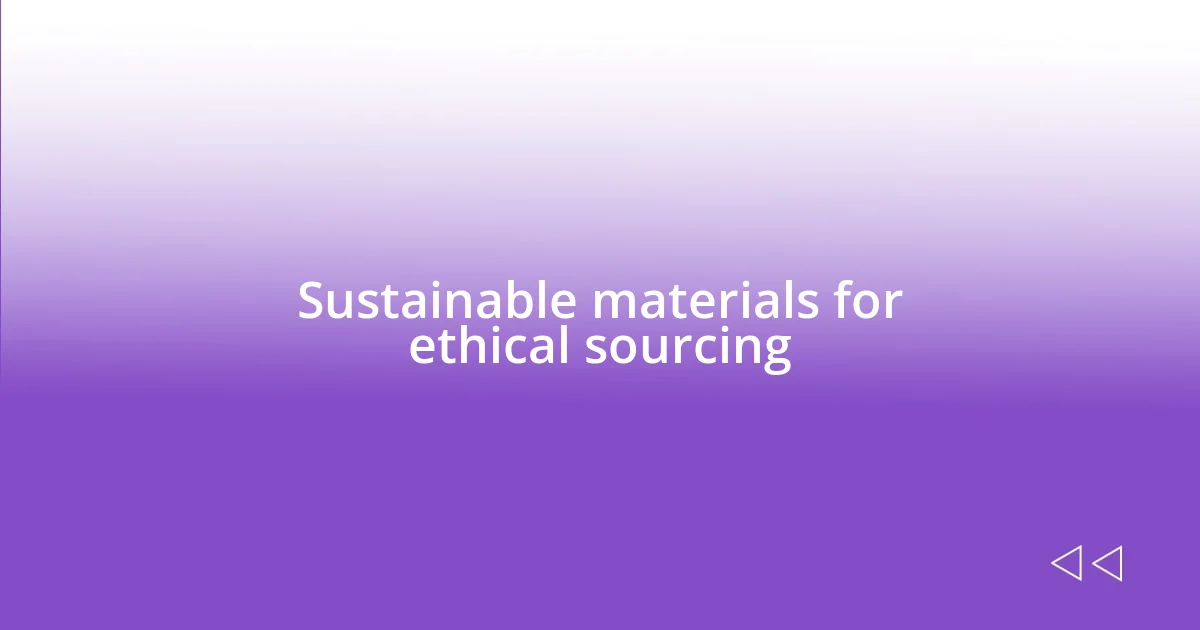
Sustainable materials for ethical sourcing
I’ve always been intrigued by the concept of sustainable materials in ethical sourcing. When I was exploring eco-friendly brands, I found a company that used bamboo as a primary material for their products. It amazed me how a fast-growing resource could reduce environmental impact while providing a variety of uses. This discovery made me wonder: why aren’t more brands adopting sustainable materials if they’re readily available?
Sustainable materials can genuinely change the game for brands committed to ethical sourcing. I recall a visit to a local marketplace where artisans showcased items made from recycled plastics. It wasn’t just about the products; it was the stories shared about how these materials were rescued from landfills and transformed into beautiful artwork. This aspect struck a chord with me—knowing that every purchase supported environmental rejuvenation and helped artisans prosper was deeply rewarding.
Using sustainable materials not only benefits the environment but also engages consumers on a deeper level. I’ve noticed that whenever I choose products made from organic cotton or reclaimed wood, it feels like I’m participating in a larger movement towards sustainability. It prompts me to ask myself: am I contributing to a better world with my choices? And honestly, every time I say yes, it fills me with a sense of purpose that goes beyond mere consumerism.
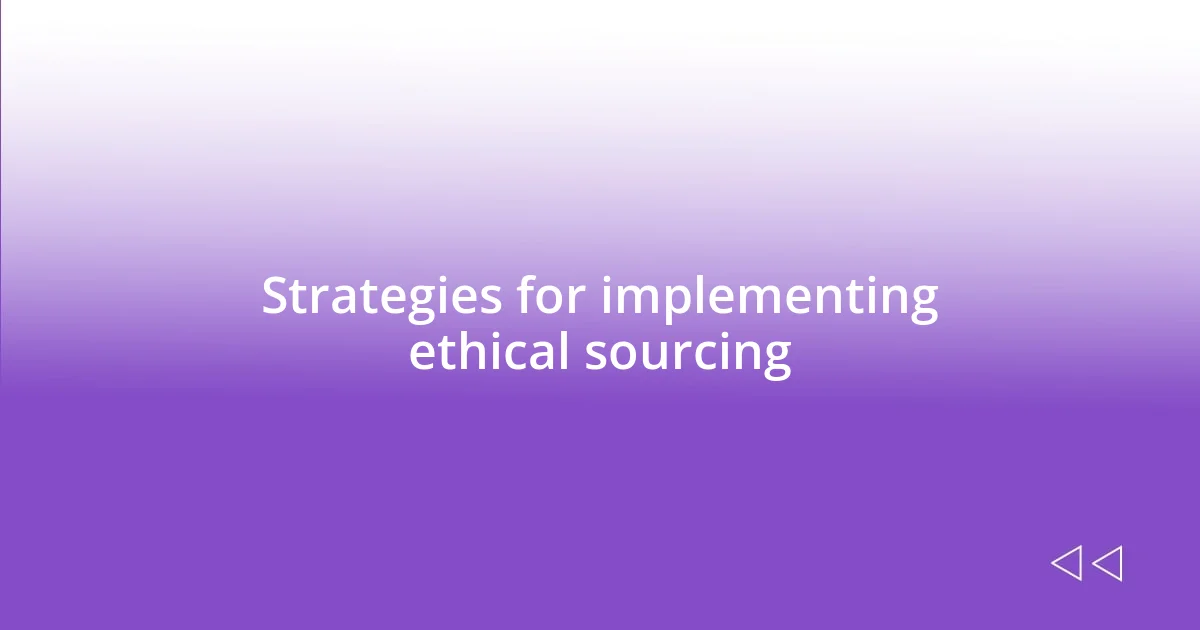
Strategies for implementing ethical sourcing
One effective strategy for implementing ethical sourcing is developing a strong supplier partnership. I remember a conversation with a small company owner who emphasized the importance of building relationships rather than just treating suppliers as transactional entities. It struck me how these partnerships foster trust and open communication, allowing for the sharing of best practices and mutual growth. Could building such relationships help us all feel more connected to the products we use?
Transparent sourcing is another crucial approach. I once volunteered for an organization that worked closely with farmers in developing countries, and I learned so much about the direct impact of where our products come from. By tracing the supply chain from farm to table, companies can provide consumers with the stories behind their purchases. This practice not only elevates brands but also empowers consumers to make informed choices—how cool is it to know exactly who benefits from your purchases?
Furthermore, leveraging technology can enhance ethical sourcing practices. I recall experimenting with an app that tracks the origin of various food products while I was shopping. It was eye-opening to see real-time data about a product’s journey. That experience made me realize how technology can hold companies accountable, driving them toward better sourcing practices. In our increasingly digital world, why not use these tools to ensure the brands we support are committed to ethical practices?
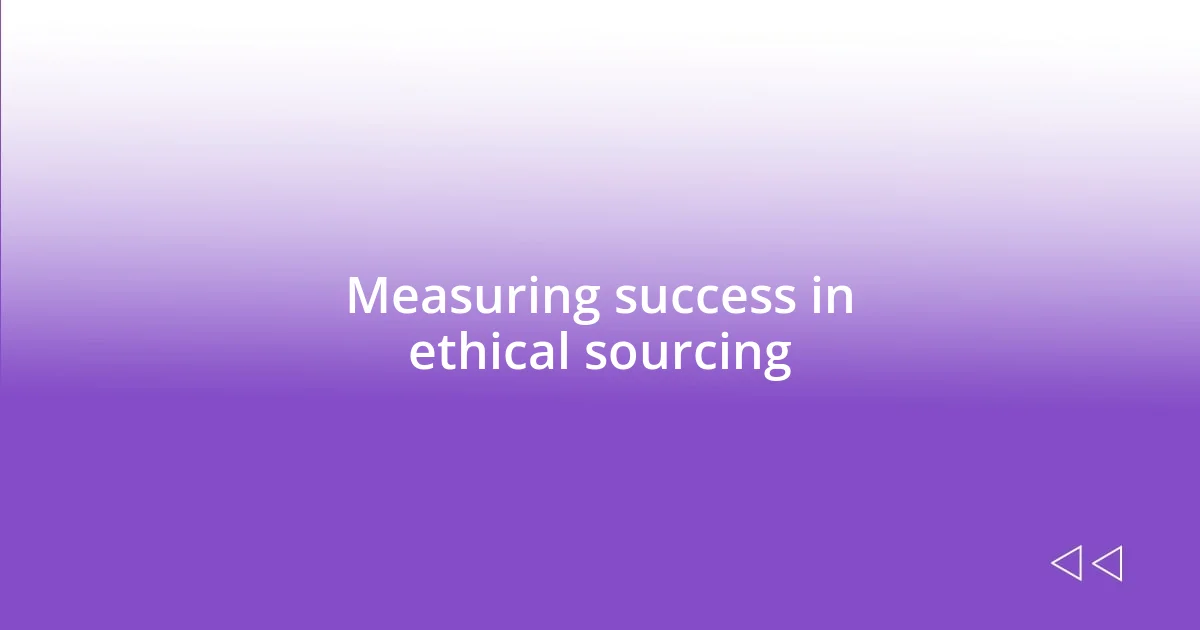
Measuring success in ethical sourcing
Measuring success in ethical sourcing can be a multifaceted endeavor. From my experience, tracking tangible results like reduced waste and improved labor conditions often speaks volumes. I recall a particularly enlightening discussion I had with a sourcing manager who shared how their metrics included worker satisfaction surveys. It was refreshing to see a company valuing employee feedback as a success indicator and not just focusing on profit margins.
Another element that caught my attention is the reliance on third-party certifications. I often look for labels like Fair Trade or Rainforest Alliance when I shop. During one of my visits to an organic market, I learned how these certifications are not just stickers; they represent a commitment to ethical practices and community support. The idea that my choices could directly contribute to better livelihoods for farmers made me realize that every product carries a story of success or failure in ethical sourcing.
Lastly, I believe storytelling plays a crucial role in measuring success. While visiting a craft fair, I met a maker who passionately shared how her sourcing decisions impacted not only her community but also the environment. Hearing her story made me think: doesn’t success also lie in how we communicate these impacts to others? It’s not just data; it’s about creating a narrative that resonates with consumers and encourages them to make responsible choices. This blend of metrics, certifications, and personal stories creates a fuller picture of what successful ethical sourcing looks like.












